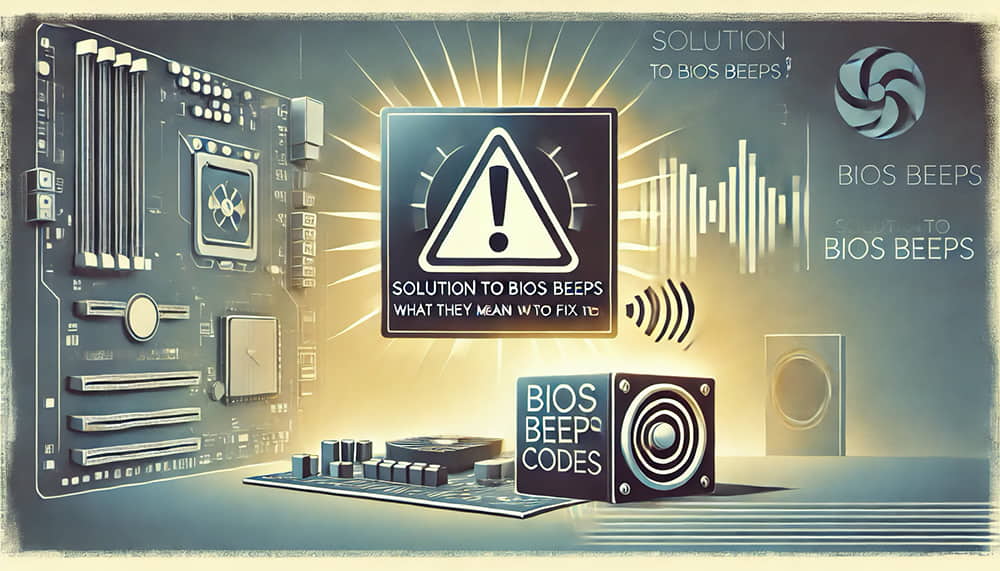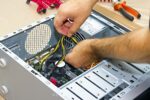When you turn on your computer and hear a series of beeps instead of the usual startup, the BIOS is likely indicating a hardware problem. These beeps are not random; they follow patterns that help us identify possible internal errors in the PC, especially those related to key components. In this guide, we will understand what BIOS beeps mean and how to fix the problems they indicate.
What are BIOS Beeps?
BIOS beeps are sound signals emitted by the motherboard when starting the computer. Each combination of beeps corresponds to a specific error and allows you to diagnose hardware problems, such as failures in the RAM, graphics card, or processor. This early diagnostic feature is part of the POST (Power-On Self-Test), a check of key components before booting the operating system.
Function and Purpose of Beeps
When we turn on the computer, the BIOS performs a series of automatic tests to ensure that the hardware is working properly. If a component fails or is unresponsive, the BIOS will emit a series of specific beeps to indicate the nature of the problem. Beeps vary by BIOS manufacturer (such as AMI, Phoenix, or Award), so it’s helpful to know your motherboard’s BIOS type to interpret them correctly.
Common Types of Beeps
While each manufacturer has its own beep codes, there are some common patterns that tend to repeat:
- Single beep: Indicates that everything is working properly and the system is ready to boot.
- Multiple short beeps: Can indicate problems with RAM or graphics errors.
- Long and short beeps combined: Can indicate problems with the keyboard, CPU, or video card.
Below, we’ll look at how to interpret some of the most common beep patterns and what actions to take in each case.
Interpreting Beeps by Sequence
Each beep sequence corresponds to a specific error. Here we show you how to interpret some of the most common beeps in AMI and Award BIOSes.
1 Long Beep and 2 Short Beeps
This combination is commonly used to indicate graphics card problems. It may be due to a poor connection to the card or, in some cases, a failure of the GPU itself.
- Solution: Check that the graphics card is properly connected to the motherboard. If you have recently upgraded the GPU or tampered with internal components, check that it is properly installed. In some cases, cleaning the contacts on the graphics card or reinstalling the drivers may solve the problem.
3 Short Beeps
Three short beeps usually indicate a problem with the RAM memory. This may be due to RAM modules being incorrectly seated, faulty, or a problem with the motherboard socket.
- Solution: Turn off the computer and open the case. Remove the RAM modules and reseat them, making sure they are fully seated. If you have multiple RAM modules, try booting the system with one at a time to identify if any specific modules are failing.
How to Resolve Problems Indicated by Beeps
Once you’ve identified the type of problem the BIOS is indicating, you can take some diagnostic steps to resolve it.
Check Hardware Connections
One of the first steps is to check all internal connections:
- Disconnect and reconnect: Make sure the major components (RAM, graphics card, hard drives) are properly connected. Over time, connections can become loose and cause errors.
- Check for loose components: Check for loose screws or parts that could be causing a short circuit on the motherboard.
- Test RAM modules and graphics card: If you have access to other compatible components, test the RAM and GPU modules in another system to rule out failures.
Update the BIOS
If problems persist, a BIOS update can be an effective solution. Sometimes, the firmware needs an update to improve compatibility with certain hardware components.
- Download Update: Visit the motherboard manufacturer’s website and look for the latest BIOS version specific to your model.
- Perform the Update: Follow the manufacturer’s instructions carefully, as an incorrect update can damage your system. It is recommended that you perform the update process in a stable environment without risk of interruptions.
Conclusion: BIOS Troubleshooting and Diagnostics
BIOS beeps are a useful tool for diagnosing hardware problems on your computer. Correctly interpreting them and knowing what to do in each case can prevent damage and costly repairs. Remember that each BIOS has its own beep codes, so it is helpful to consult your motherboard manual. The key to solving these problems is to perform an accurate diagnosis and follow the recommendations to resolve the error, thus ensuring a stable and functional system startup.







